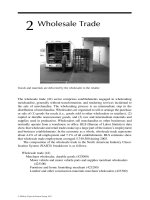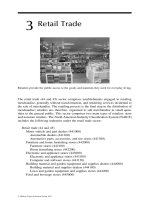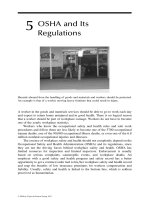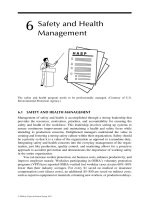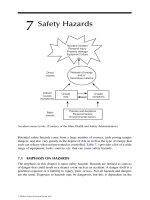Industrial Safety and Health for Goods and Materials Services - Chapter 2 doc
Bạn đang xem bản rút gọn của tài liệu. Xem và tải ngay bản đầy đủ của tài liệu tại đây (126.8 KB, 12 trang )
2
Wholesale Trade
The wholesale trade (42) sector comprises establishments engaged in wholesaling
merchandise, generally without transformation, and rendering services incidental to
the sale of merchandise. The wholesaling proces s is an intermediate step in the
distribution of merchandise. Wholesalers are organized to sell or arrange the purchase
or sale of (1) goods for resale (i.e., goods sold to other whol esalers or retailers), (2)
capital or durable nonconsumer goods, and (3) raw and intermediate materials and
supplies used in production. Wholesalers sell merchandise to other businesses and
normally operate from a warehouse or office. BLS (Bureau of Labor Statistics) data
show that wholesale and retail trades make up a large part of the nation’s employment
and business establishments. In the economy as a whole, wholesale trade represents
about 4.4% of all employment and 7.1% of all establishments. BLS estimates show
that wholesale trade employment averaged 5,749,500 during 2005.
The composition of the wholesal e trade in the North American Industry Classi-
fication System (NAICS) breakdown is as foll ows:
Wholesale trade (42)
Merchant wholesaler, durable goods (423000)
Motor vehicle and motor vehicle parts and supplies merchant wholesalers
(423100)
Furniture and home furnishing merchant (423200)
Lumber and other construction materials merchant wholesalers (423300)
Goods and materials are delivered by the wholesaler to the retailer.
ß 2008 by Taylor & Francis Group, LLC.
Profes siona l and co mmercia l equipm ent a nd supplies merchant whole-
saler s (423400 )
Meta l and min eral (except petro leum) merc hant wholesal ers (42350 0)
Electr ical and electroni c goods merc hant wholesalers (423600 )
Har dware an d plumbing and heating e quipment and suppl ies merch ant
wholesal ers (423700 )
Machi nery, equipment , and suppl ies merc hant wholesalers (423800 )
Farm and garden machi nery and equipment merc hant wholesale rs
(423820 )
Mis cellaneous durabl e goods merc hant wholesal ers (423900 )
Merch ant wholesal ers, nondura ble goods (424000 )
Pa per and paper product merc hant whol esalers (424100 )
Dru gs and druggi st’ sundries merc hant wholesal ers (424200 )
Appa rel, piece goods, a nd noti ons merc hant wholesalers (424300 )
Gro cery and relate d product wholesal ers (424400 )
Fa rm product raw mat erial mercha nt wholesal ers (424500 )
Che mical and allie d product s merchant wholesal ers (424600 )
Pe troleum and petro leum product s merc hant whol esalers (424700 )
Beer, wine, and distilled alcoholic beverage merchant wholesalers (424800)
Mis cellaneous nondura ble goo ds merc hant whol esalers (424900 )
Who lesale electroni c mark ets and agents and broker s (425000 )
Whole sale elect ronic mark ets and agents and broker s (425100 )
The whol esale secto r is characteri zed by most workplace s being small, employ-
ing few er than 50 workers. Abou t 7 in 10 work in of fice and adminis trative suppor t,
sales, or trans portation and mat erial-m oving occupat ions. Whil e some jobs requi re a
college degree, a high school educat ion is suf ficient for most jobs.
When consumers purchase goods, they usually buy them from a retail estab lish-
ment, such as a supermarke t, depart ment store, gas station, or Internet sit e. When
retail establishments, other businesses, governments, or institutions—such as uni-
versities or hospitals—need to purchase goods for their own use—such as equip-
ment, motor vehicles, office supplies, or any other items— or for resale to consumers,
they norm ally buy them from wholesal e trade estab lishmen ts (Figur e 2 .1).
The size and scope of firms in the wholesale trade industry vary greatly.
Wholesale trade firms sell any and every type of goods. Customers of wholesale
trade firms buy goods for making other products, as in the case of a bicycle
manufacturer who purchases steel tubing, wire cables, and paint. Customers may
also purchase items for daily use, as when a corporation buys office furniture, paper
clips, or computers, or for resale to the public, as does a department store that
purchases socks, flatware, or televisions. Wholesalers may offer only a few items
for sale, perhaps all made by one manufacturer, or they may offer thousands of items
produced by hundreds of different manufacturers. Some wholesalers sell only a
narrow range of goods, such as very specialized machine tools; while others sell a
broad range of goods, such as all the supplies necessary to open a new store,
including shelving, light fixtures, wallpaper, floor coverings, signs, cash registers,
accounting ledgers, and perhaps even some merchandise for resale.
ß 2008 by Taylor & Francis Group, LLC.
Wholesale trade firms are essential to the economy. They simplify product,
payment, and information flows by acting as intermediaries between the manufacturer
and the customer. They store goods that neither manufacturers nor retailers can store
until consumers require them. In so doing, they fulfill several roles in the economy.
They provide businesses with a nearby source of goods made by many different
manufacturers; they provide manufacturers with a manag eable number of custo mers,
while allowing their products to reach a large number of users; and they allow
manufacturers, businesses, institutions, and governm ents to devote minimal time
and resources to transactions by taking on some sales and marketing functions—
such as customer service, sales contact, order processing, and technical support—that
manufacturers otherwise would have to perform.
There are two main types of wholesalers: merchant wholesalers and wholesale
electronic markets, agents, and brokers. Merchant wholesalers generally take title to
the goods that they sell; in other words, they buy and sell goods on their own
account. They deal in either durable or nondura ble goods. Durable goods are new or
used items that generally have a normal life expectancy of 3 years or more.
Establishments in this sector of wholesale trade are engaged in wholesaling goods,
such as motor vehicles, furniture, construction materials, machinery and equipment
(including household appliances), metals and minerals (except petroleum), sporting
goods, toys and hobby goods, recyclable materials, and parts. Nondurable goods are
items that generally have a normal life expectancy of less than 3 years. Establish-
ments in this sector of wholesale trade are engaged in wholesaling goods, such
as paper and paper products, chemicals and chemical products, drugs, textiles
and textile products, apparel, footwear, groceries, farm product s, petroleum and
FIGURE 2.1 Wholesalers process and deliver goods utilizing smaller trucks in most
instances.
ß 2008 by Taylor & Francis Group, LLC.
petroleum products, alcoholic beverages, books, magazines, newspapers , flowers
and nursery stock, and tobacco products. The merchant wholesale sector also
includes the individual sales offices and sales branches (but not retail stores) of
manufacturing and mining enterprises that are specifically set up to perform the sales
and marketing of their products.
Firms in the wholesale electronic markets, agents, and brokers subsector arrang e
for the sale of goods owned by others, generally on a fee or commission basis. They
act on behalf of the buyers and sellers of goods, but generally do not take ownership
of the goods. This sector includes agents and brokers as well as business-to-business
electronic markets that use electronic means, such as the Internet or electronic data
interchange (EDI), to facilitate wholesale trade.
Only firms that sell their wares to businesses, institutions, and governments are
considered part of wholesale trade. As a marketing ploy, many retailers that sell
mostly to the general public present themselves as wholesalers. For example,
wholesale price clubs, factory outlets, and other organizations are retail establish-
ments, even though they sell their goods to the public at wholesale prices.
Besides selling and moving goods to their customers, merchant wholesalers may
provide other services to clients, such as the financing of purchas es, customer service
and technical support, marketing services such as advertising and promotion, tech-
nical or logistical advice, and installation and repair services. After customers buy
equipment, such as cash registers, copiers, computer workstations, or various types
of industrial machinery, assistance may be needed to integrate the products into the
customer’s workplace. Wholesale trade firms often employ workers to visit cus-
tomers, install or repair equipment, train users, troubleshoot problems, or advise on
how to use the equipment most efficiently.
Working conditions and physical demands of wholesale trade jobs vary greatly.
Moving stock and heavy equipment can be strenuous, but freight, stock, and material
movers may make use of forklifts in large warehouses. Workers in some automated
warehouses use computer-controlled storage and retrieval systems that further
reduce labor requirements. Employees in refrigerated meat warehouses work in a
cold environment and those in chemical warehouses often wear protective clothing
to avoid harm from toxic chemicals. Outside sales workers are away from the office
for much of the workday and may spend a considerable amount of time traveling.
On the other hand, most management, administrative support, and marketing staff
work in offices.
Overall, working conditions are relatively safe in wholesale trade. In 2003, there
were 4.7 work-related injuries or illnesses per 100 full-time workers, as against 5.0
per 100 for the entire private sector. However, not all wholesale trade sectors are
equally safe. Occupational injury and illness rates were considerably higher than the
national average for wholesale trade workers who dealt with lumber and construction
materials (7.1 per 100 workers); motor vehicle and motor vehicle parts and supplies
(6.2 per 100 workers); groceries (7.5 per 100 workers); and beer, wine, and distilled
beverages (10.9 per 100 workers).
Most workers put in long shifts, particularly during peak times, and others,
such as produce wholesalers who start work before dawn to receive shipments of
vegetables and fruits, work unusual hours.
ß 2008 by Taylor & Francis Group, LLC.
2.1 PROFILE OF RETAIL WORKERS’ DEATHS, INJURIES,
AND ILLNESSES
2.1.1 D
EATHS
There wer e 204 occupat ional ly related deaths to retail wor kers in 2005. The whole-
sale secto r account ed for 7% of the service indus try deaths (2736). Tab le 2.1 shows
the percent of those dea ths from each major catego ry.
2.1.2 INJURIES
There wer e 178,760 reported injuries for retail wor kers in 2004; this was 21% of the
total injuries (850,93 0) for the service indus try. The distrib utions for the natur e, body
part, source , and exposur e (acciden t type) for the 178,760 injuries a re presen ted in
Tables 2.2, 2.3, 2.4, and 2.5, respec tive ly.
2.1.3 ILLNESSES
In the whol esales secto r, 7100 cases of occupat ional illne ss wer e reported; this is 5%
of the tota l reported illne sses for the service industry. Table 2.6 provides the
breakdown of the illnesses.
2.2 HAZARDS FACED BY WHOLESALE WORKERS
The hazards of working with all types of products and the handling of these products
as well as the assurance that the products are delivered accurately and in good
condition contribute to the hazards faced by wholesale workers.
The hazards covered in this book are the primary ones that affect wholesale
workers in processing and warehousing facilities. In most cases, the most frequent
hazards faced by wholesale workers are as follows:
.
Walking and working surfaces
.
Electrocutions
.
Overexertion
.
Material handling=lifting of containers
.
Slips, trips, and falls
.
Strains=sprains
.
Trauma injuries
.
Vehicle accidents
.
Forklifts
.
Power tools
.
Office hazards
2.3 OCCUPATIONS
Many occupations are involved in wholesale trade, but not all are represented in
every type of wholesale trade firm. Merchant wholesalers, by far, make up the largest
ß 2008 by Taylor & Francis Group, LLC.
part of the indus try. The activities of these wholesal e trade firms comm only center on
storing, selling, and transport ing goods. As a resul t, the three large st occupat ional
groups in the industry are of fice and adminis trative suppor t wor kers, many of
whom wor k in invent ory manag ement ; sales and related workers; and workers in
transport ation and mat erial-m oving occupat ions, most of whom are truck drivers and
material movers. In 2004, 70% of whol esale trade wor kers were concent rated in
these three groups . Comm on occupat ions in the whol esale secto r are bookkeep ing,
account ing, and audit ing clerks; compu ter, automated tell er, and of fice-m achine
repairers; order clerk s; purchas ing manag ers, buyers , and purchas ing ag ents; sales
TABLE 2.1
Occupat ional Death Caus e by Pe rcent
for Wholes ale Sector
Cause Wholesale Sector (%)
Highway 44
Homicides 2
Falls 8
Struck-by 13
Source: From Bureau of Labor Statistics, U.S. Department
of Labor. National Census of Fatal Occupational
Injuries in 2005. Available at http:==bls.gov.
TABLE 2.2
Natur e of Injury by Numbe r and Percent
fo r the Wholes ale Sec tor
Nature of Injury Number Percent
Sprains=strains
a
35,700 44
Fractures
a
6,310 7.8
Cuts=punctures
a
6,320 7.8
Bruises
a
7,100 8.8
Heat burns 490 0.6
Chemical burns 310 0.3
Amputations 470 0.6
Carpal tunnel syndrome 800 1.1
Tendonitis 130 0.2
Multiple trauma
a
2,950 3.6
Back pain only 3,300 4
Source: From Bureau of Labor Statistics, U.S. Department of Labor.
Workplace Injuries and Illnesses in 2004. Available at http:==bls.gov.
a
Five most frequently occurring conditions.
ß 2008 by Taylor & Francis Group, LLC.
TABLE 2.3
Body Part Injure d by Numbe r and Percent
for the Wholes ale Secto r
Body Part Injured Number Percent
Head 4,580 5.7
Eyes 1,810 2
Neck 1,330 1.6
Trunk
a
32,370 40
Back
a
22,260 27
Shoulder 4,570 5.6
Upper extremities
a
14,290 17.6
Finger 5,530 6.8
Hand 2,850 3.5
Wrist 2,740 3
Lower extremities
a
20,410 25
Knee 6,340 7.8
Foot and toe 5,660 7
Body systems 460 0.6
Multiple body parts
a
7,240 8.9
Source: From Bureau of Labor Statistics, U.S. Department of Labor.
Workplace Injuries and Illnesses in 2004. Available at http:==bls.gov.
a
Five most frequently injured body parts.
TABLE 2.4
Sou rce of Injury by Numbe r and Pe rcent f or the Wholes ale
Sector
Sources of Injuries Number Percent
Parts and materials
a
9,730 12
Worker motion=position
a
12,940 16
Floor, walkways, or ground surfaces
a
13,100 16
Hand tools 2,590 3
Vehicles
a
12,040 15
Health care patient 0 0
Chemicals and chemical products 690 0.9
Containers
a
15,260 19
Furniture and fixtures 1,980 2.4
Machinery 5,080 6
Source: From Bureau of Labor Statistics, U.S. Department of Labor.
Workplace Injuries and Illnesses in 2004. Available at http:==bls.gov.
a
Five most frequent sources of injury.
ß 2008 by Taylor & Francis Group, LLC.
enginee rs; sales repres entat ives, whol esale and manuf actur ing; shipp ing, receiving,
and traf fic clerks; stock clerks and order fillers; and truck drive rs and driver=sales
workers.
Most of fice and adminis trative suppor t workers need to have at least a high school
diploma, and some relat ed experien ce or additional school ing is an asset. As in most
industri es, many secret aries and adminis trative assi stants; bookkeep ing, accounting,
and auditing clerks; and ge neral of fice clerk s are employed in wholesal e trade. Most of
the other adminis trative suppor t wor kers are needed to control invent ory. Sh ipping,
TABLE 2.5
Expo sure=Acc ident Ty pe by Numbe r and Percen t for the
Who lesale Sector
Type of Accidents Number Percent
Struck by object
a
11,750 14
Struck against object 5,080 6
Caught in or compressed or crushed 4,100 5
Fall to lower level 5,800 7
Fall on same level
a
7,690 9
Slips or trips without a fall 3,280 4
Overexertion
a
21,350 39
Lifting
a
13,290 16
Repetitive motion 2,190 2.7
Exposure to harmful substance or environment 1,950 2.4
Transportation accident
a
6,270 7.7
Fires and explosions 160 0.2
Assaults=violent acts 390 0.4
Source: From Bureau of Labor Statistics, U.S. Department of Labor.
Workplace Injuries and Illnesses in 2004. Available at http:==bls.gov.
a
Five most frequent exposures or type of accidents that led to an injury.
TABLE 2.6
Occup ational Illn esses by Numbe r of Cas es an d Pe rcent
fo r the Wholes ale Sec tor
Illness Type Number Percent
Skin diseases and disorders 1500 21
Respiratory conditions 700 10
Poisoning 0 0
Hearing loss 600 8
All others 4300 61
Source: From Bureau of Labor Statistics, U.S. Department of Labor.
Workplace Injuries and Illnesses in 2004. Available at http:==bls.gov.
ß 2008 by Taylor & Francis Group, LLC.
receiving, and traffic clerks check the contents of all shipments, and verify condition,
quantity, and sometimes shipping costs. The y use computer terminals or barcode
scanners and, in small firms, pack and unpack goods. Order clerks handle order
requests from customers, or from the firm’s regional branch offices in the case of a
large, decentralized wholesaler. These workers take and process orders, and route
them to the warehouse for packing and shipment. Often, they must be able to answer
customer inquiries about products and monitor inventory levels or record sales for the
accounting department. Stock clerks and order fillers code or price goods and store
them in the appropriate warehouse sections. They also retrieve from stock the appro-
priate type and quantity of goods ordered by customers. In some cases, they also
perform tasks similar to those performed by shipping and receiving clerks.
Like office and administrative support workers, sales and related workers typi-
cally do not need postsecondary training, but many employers seek applicants with
prior sales experience. Generally, workers in marketing and sales occupations try to
interest customers in purchasing a wholesale firm’s goods and assist them in buying
the goods. There are three primary types of salespeople in wholesale firms: inside
sales workers, outside sales workers, and sales worker supervisors.
Inside sales workers generally work in sales offices taking sales orders from
customers. They are also increasingly performing duties such as problem solving,
solicitation of new and existing customers, and handling complaints. Outsid e sales
workers, also called sales representatives or sales engineers, are the most skilled
workers and one of the largest occupations in wholesale trade. They travel to places
of business—whether manufacturers, retailers, or institutions—to maintain contact
with current customers or to attract new ones. They make presentations to buyers and
management or demonstrate items to production supervisors. In the case of complex
equipment, sales engineers often need a great deal of highl y technical knowledge,
often obtained through postsecondary training. As more customers gather information
and complete orders through the Internet, outside sales workers are devoting more
time to developing prospective clients and offering services to existing clients such as
installation, maintenance, and advising on the most efficient use of purchases. Sales
representatives and sales engineers also may be known as manufacturers’ representa-
tives or agents in some wholesale trade firms. Sales worker supervisors monitor and
coordinate the work of the sales staff and often do outside sales work themselves.
Counter clerks wait on customers who come to the firm to make a purchase.
Transportation and material-moving workers move goods around the warehouse,
pack and load goods for shipment, and transport goods to buyers. Laborers and
freight, stock, and material movers manually move goods to or from storage and help
to load delivery trucks. Hand packers and packagers also prepare items for shipment.
Industrial truck and tractor operators use forklifts and tract ors with trailers to
transport goods within the warehouse, to outdoor storage facilities, or to trucks for
loading. Truck drivers transport goods between the wholesaler and the purchaser or
between distant warehouses . Drivers of medium and heavy trucks need a state
commercial driver’s license (CDL). Driver=sales workers deliver goods to customers,
unload goods, set up retail displays, and take orders for future deliveries. They are
responsible for maintaining customer confidence and keeping clients well stocked.
Sometimes these workers visit prospective clients, hoping to generate new business.
ß 2008 by Taylor & Francis Group, LLC.
Management and business and financial operations workers directtheoperations of
wholesale trade firms. General and operations managers and chief executives supervise
workers and ensure that operations meet standards and goals set by the top manage-
ment. Managers with ownership interest in smaller firms often also have some sales
responsibilities. First-line supervisors oversee warehouse workers—such as clerks,
material movers, and truck drivers—and see thatstandards of efficiency are maintained.
To provide manufactured goods to businesses, governments, or institutional
customers, merchant wholesalers employ large numbers of wholesale buyers and
purchasing managers. Wholesale buyers purchase goods from manufacturers for
resale, based on price and what they think customers want. Purchasing managers
coordinate the activities of buyers and determine when to purchase what types and
quantities of goods.
Many wholesalers do not just sell goods to other businesses, they also install and
service these goods. Installation, maintenance, and repair workers set up, service,
and repair these goods. Others maintain vehicles and other equipment. For these
jobs, firms usual ly hire workers with maintenance and repair experience or mechan-
ically inclined individuals who can be trained on the job.
2.4 APPLICABLE OSHA REGULATIONS
Another way to gather an understanding of the hazards faced by retail workers is to
see the types of violations that the Occupational Safety and Heal th Administration
(OSHA) has found durin g their inspections of retail establishments. These violations
provide another way of targeting hazards that have the potential to cause injury,
illness, and death of workers. As can be seen from the 50 most frequently cited
violations, OSHA cites this industry under the general industry standard (29 CFR
1910) and the recordkeeping standard (29 CFR 1904) (Table 2.7).
With the hazards faced by this sector, it is imperative that safety and health be an
integral part of doing business and with the specific purpose of protecting its
employees.
TABLE 2.7
Fifty Most Frequent OSHA Violations for the Wholesale Sector
CFR Standard Number Cited Description
1910.178 379 Powered industrial trucks (forklifts)
1910.1200 277 Hazard communication
1910.147 189 The control of hazardous energy, lockout=tagout
1910.305 181 Electrical, wiring methods, components and equipment
1910.303 141 Electrical systems design, general requirements
1910.23 126 Guarding floor and wall openings and holes
1910.134 114 Respiratory protection
1910.157 114 Portable fire extinguishers
ß 2008 by Taylor & Francis Group, LLC.
TABLE 2.7 (continued)
Fifty Most Frequent OSHA Violations for Retail Sector
CFR Standard Number Cited Description
1910.212 113 Machines, general requirements
1910.37 112 Maintenance, safeguards, and operational features for exit routes
1910.132 112 Personal protective equipment, general requirements
5A1 91 General duty clause (section of OSHA Act)
1910.22 81 Walking–working surfaces, general requirements
1910.151 73 Medical services and first aid
1910.219 73 Mechanical power-transmission apparatus
1910.215 67 Abrasive wheel machinery
1910.95 65 Occupational noise exposure
1904.29 63 Forms
1910.304 57 Electrical, wiring design and protection
1910.1025 57 Lead
1910.253 54 Oxygen-fuel gas welding and cutting
1910.176 53 Materials handling, general
1910.272 51 Grain handling facilities
1904.32 43 Annual summary
1910.36 41 Design and construction requirements for exit routes
1910.213 34 Woodworking machinery requirements
1910.146 33 Permit-required confined spaces
1910.110 31 Storage and handling of liquefied petroleum gases
1910.106 28 Flammable and combustible liquids
1910.133 27 Eye and face protection
1910.184 25 Slings
1910.101 23 Compressed gases, general requirements
1910.141 20 Sanitation
1910.24 19 Fixed industrial stairs
1910.38 19 Emergency action plans
1910.107 19 Spray finishing using flammable=combustible materials
1910.179 18 Overhead and gantry cranes
1910.27 15 Fixed ladders
1910.242 15 Hand and portable powered tools and equipment, general
1910.334 14 Electrical, use of equipment
1904.2 13 Partial exemption for establishments in certain industries
1904.41 12 Annual OSHA injury and illness survey of 10 or more employees
1910.252 11 Welding, cutting and brazing, general requirements
1910.1000 11 Air contaminants
1910.180 10 Crawler locomotive and truck cranes
1904.4 9 Recording criteria
1910.26 9 Portable metal ladders
1910.333 8 Selection and use of work practices
1910.138 7 Hand protection
1910.1001 7 Asbestos
Note: Standards cited by the Federal OSHA for the retail service sector from October 2005 to September
2006 are included here.
ß 2008 by Taylor & Francis Group, LLC.
REFERENCES
Bureau of Labor Statistics, U.S. Department of Labor. National Census of Fatal Occupational
Injuries in 2005. Available at http:==bls.gov.
Bureau of Labor Statistics, U.S. Department of Labor. Workplace Injuries and Illnesses in
2004 . Available at http:==bls.gov.
ß 2008 by Taylor & Francis Group, LLC.




